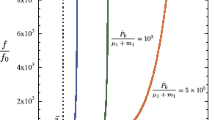Abstract
The viewpoint that cavitation in rubber—that is, the sudden growth of inherent defects in rubber into large enclosed cavities in response to external stimuli—is a purely elastic phenomenon has long been known to be fundamentally incomplete. Essentially, this is because the local stretches around the defects at which cavitation initiates far exceed the elastic limit of the rubber, which therefore ought to inelastically deform by fracturing to accommodate their growth. Yet, rather remarkably, the classical heuristic elastic criterion stating that cavitation occurs at material points wherein the hydrostatic component of the stress reaches the critical value \(P=5/2\mu \), with \(\mu \) denoting the initial shear modulus of the rubber, has been shown to agree reasonably well with a number of experimental observations. This agreement suggests that the elastic properties of rubber may play a significant—possibly even dominant—role on the occurrence of cavitation. The purpose of this paper is to provide insight into the relevance of the elastic properties of rubber on the phenomenon of cavitation. To this end, the comprehensive elastic cavitation theory recently put forward by Lopez-Pamies et al. (J Mech Phys Solids 59:1464–1487, 2011a) is directly confronted to two classical sets of experiments that to date have been understood only in part: (i) the poker-chip experiments of Gent and Lindley (Proc R Soc Lond A 249:195–205, 1959) and (ii) the experiments of Gent and Park (J Mater Sci 19:1947–1956, 1959) dealing with cavitation near reinforcing filler particles. Specifically, both sets of experiments are theoretically reproduced under the assumptions that the underlying rubber is Gaussian (for any arbitrarily large deformation) and that its inherent defects are vacuous and isotropically distributed. Results are presented for when and where cavitation occurs in the specimens as well as for the ensuing growth and interaction of the cavities once they have been “nucleated”. It is found that the elastic theoretical results are in good agreement with many of the qualitative but few of the quantitative features of the experiments. The reasons behind this remarkable partial agreement and its practical implications are discussed.





















Similar content being viewed by others
Notes
Again, equation (10) as derived by Gent and Lindley (1959), corresponds to the case of a single defect that is vacuous and spherical in shape. By contrast, the result (9) corresponds to a random isotropic distribution of vacuous defects (not just one, but a distribution of infinitely many) which are not necessarily spherical in shape. Section 5 of Lopez-Pamies et al. (2011a) elaborates further on such a remarkable connection between the cavitation criterion (3)–(6) and the results of Gent and Lindley (1959) and of Ball (1982).
Gent and Park (1984) also studied specimens containing a single spherical filler particle. This simpler case is not considered here.
References
ABAQUS (2011) ABAQUS version 6.11 Documentation. Dassault Systemes Simulia Corp., Providence
Ball JM (1982) Discontinuous equilibrium solutions and cavitation in nonlinear elasticity. Philos Trans R Soc A 306:557–611
Bayraktar E, Bessri K, Bathias C (2008) Deformation behaviour of elastomeric matrix composites under static loading conditions. Eng Fract Mech 75:2695–2706
Gent AN, Lindley PB (1959) Internal rupture of bonded rubber cylinders in tension. Proc R Soc Lond A 249:195–205
Gent AN, Park B (1984) Failure processes in elastomers at or near a rigid inclusion. J Mater Sci 19:1947–1956
Gent AN (1991a) Cavitation in rubber: a cautionary tale. Rubber Chem Technol 63:G49–G53
Gent AN, Wang C (1991b) Fracture mechanics and cavitation in rubber-like solids. J Mater Sci 26:3392–3395
Griffith AA (1921) The phenomena of rupture and flow in solids. Philos Trans R Soc Lond A221:163–198
Lopez-Pamies O (2009) Onset of cavitation in compressible, isotropic, hyperelastic solids. J Elast 94:115–145
Lopez-Pamies O, Idiart MI, Nakamura T (2011a) Cavitation in elastomeric solids: I—a defect-growth theory. J Mech Phys Solids 59:1464–1487
Lopez-Pamies O, Nakamura T, Idiart MI (2011b) Cavitation in elastomeric solids: II—onset-of-cavitation surfaces for Neo-Hookean materials. J Mech Phys Solids 59:1488–1505
Oberth IE, Bruenner RS (1965) Tear phenomena around solid inclusions in castable elastomers. Trans Soc Rheol 9:165–185
Stringfellow R, Abeyaratne R (1989) Cavitation in an elastomer: comparison of theory with experiment. Mater Sci Eng A 112:127–131
Williams ML, Schapery RA (1965) Spherical flaw instability in hydrostatic tension. Int J Fract Mech 1:64–72
Acknowledgments
This work was supported by the National Science Foundation through Grants DMS–1009503 and CMMI–1235352.
Author information
Authors and Affiliations
Corresponding author
Electronic supplementary material
Below is the link to the electronic supplementary material.
Supplementary material 1 (avi 9299 KB)
Supplementary material 2 (avi 4553 KB)
Rights and permissions
About this article
Cite this article
Lefèvre, V., Ravi-Chandar, K. & Lopez-Pamies, O. Cavitation in rubber: an elastic instability or a fracture phenomenon?. Int J Fract 192, 1–23 (2015). https://doi.org/10.1007/s10704-014-9982-0
Received:
Accepted:
Published:
Issue Date:
DOI: https://doi.org/10.1007/s10704-014-9982-0




